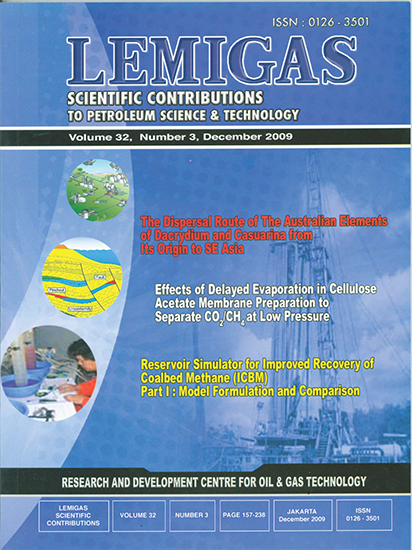The Dispersal Route Of The Australian Elements Of Dacrydium And Casuarina From Its Origin To Se Asia
DOI:
https://doi.org/10.29017/SCOG.32.3.846Keywords:
Dispersal route, Australian elements, Dacrydium and Casuarina, SE AsiaAbstract
This paper proposes the alternative migration route of the Australian elements of Dacrydium and Casuarina from their origin to Southeast Asia. It was previously thought that these Australian affinities dispersed to Sunda region following the collision of the Australian and the Asian plates at the Oligo- cene boundary (Morley, 1998 and 2000).The subsequent study by Lelono (2007) extended the record of these two taxa from the Oligo-Miocene boundary to the base Oligocene. This is unlikely, since at the time of basal Oligocene, when these pollen types first appear, the Australian land mass would have been some 1000 kms south of the East Java area. Therefore, this fact led Lelono (2007) to propose the earlier arrival of the Gondwanan fragment to this area in Early Oligocene. However, recent records of Dacrydium have been reported from the Early Eocene of the Ninety East Ridge (55 Ma) and the Indian subcontinent (50 Ma) (Morley, 2009). This implies to the alternative dispersal route of this pollen. It is possible that Dacrydium dispersed into SE Asia prior to the Early Oligocene via the Ninety East Ridge and the Indian plate, and subsequently its distribution across the Sunda region and Indochina was limited by palaeoclimate, explaining why it is present in some areas of the Sunda region, but not others. Mean while, a model to explain the dispersal of Casuarina remains unresolved, since migration via India is unlikely as there is no pollen record from the Indian subcontinent. Therefore, long distance dispersal may be a possibility for this pollen.
References
Hall, R., 2002. Cenozoic Geological and Plate Tectonic
Evolution of SE Asia and the SW Pacific:
Computer-Based reconstruction, Model and Animations.
Journal of Asian Earth Sciences, Vol.
, No. 4.
Lelono, E. B., 2007, Gondwanan Palynomorphs
from the Paleogene Sediment of East Java: ?The
Evidence of Earlier Arrival. Proceeding of Indonesian
Geologist Association (IAGI), 36th
Annual Convention, Bali.
Lelono, E. B. and Morley, R. J., 2009. Oligocene
Palynological Succession from the East Java Sea.
In: Hall, R., Cottam, M. and Wilson, M. (eds).
The SE Asian gateway: History and Tectonic
of Australia-Asia Collision. Geological Society
of London, Special Publication. In press.
Morley, R.J., 1998, Palynological evidence for Tertiary
plant dispersals in the Southeast Asian region
in relation to plate tectonics and climate. In:
Hall, R. and Holloway, J.D., (eds), Biogeography
and Geological evolution of SE Asia.
Backhuys, Leiden, pp 211-234.
Morley, R. J. 2000. Origin And Evolution Of
Tropical Rain Forests. Wiley, London.
Morley, R.J., 2009. Palaeoecology of Tropical
Podocarps. In: Turner, B. (ed), Tropical
Podocarps. Smithsonian Tropical Research Institute,
Panama. In press.
Pusoko, S., Sofyan, S., Rahardjo, K. and Endarto,
M., 2005. Hydrocarbon Evaluation of North East
Java (Madura). Unpublished Report of Lemigas
In-house Reseacrh.
Smyth, H., Hall, R., Hamilton, J. and Kinny, P.
Volcanic Origin of Quartz-Rich Sediment
in East Java. Proceeding Indonesian Petroleum
Association, 29th Annual Convention and Exhibition,
Jakarta.
Sribudiyani, Muchsin, N., Ryacudu, R., Kunto, T.,
Astono, P., Prasetya, I., Sapiie, B., Asikin, S.,
Harsolumakso, A. H. and Yulianto,I. 2003. The
Collision of the East Java Microplate and Its Implication
for Hydrocarbon Occurrences in the East
Java Basin. Proceeding Indonesian Petroleum
Association, 29th Annual Convention and Exhibition,
Jakarta.
Downloads
Issue
Section
License
Copyright (c) 1970 SCIENTIFIC CONTRIBUTIONS OIL AND GAS (SCOG)

This work is licensed under a Creative Commons Attribution 4.0 International License.
Authors are free to Share — copy and redistribute the material in any medium or format for any purpose, even commercially Adapt — remix, transform, and build upon the material for any purpose, even commercially.
The licensor cannot revoke these freedoms as long as you follow the license terms, under the following terms Attribution — You must give appropriate credit , provide a link to the license, and indicate if changes were made . You may do so in any reasonable manner, but not in any way that suggests the licensor endorses you or your use.
No additional restrictions — You may not apply legal terms or technological measures that legally restrict others from doing anything the license permits.














